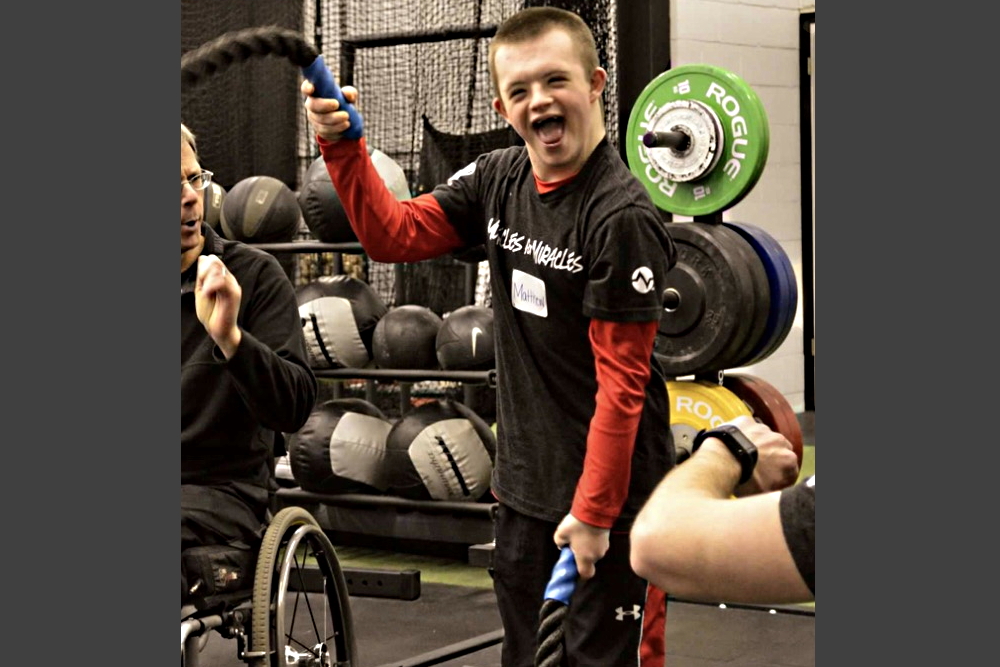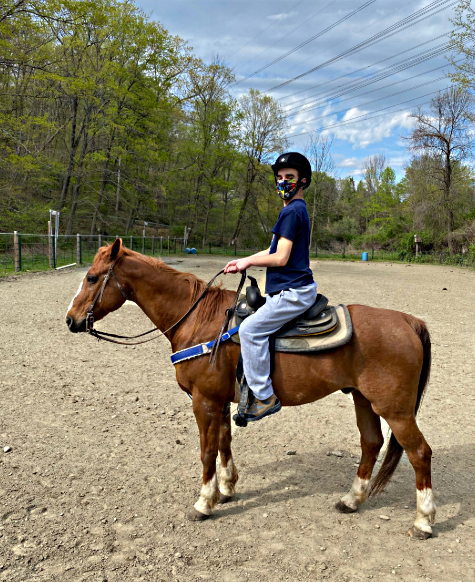
Photo courtesy Matthew Bishop's family
Miracle League baseball player Matthew Bishop, 20, who has Down syndrome, works out at a Pennsylvania gym.
For the first time, when he was 11, Matthew Bishop got to play competitive sports with athletes who, like him, had Down syndrome or some other disability. They did so through Miracle League, which arrived in Bishop’s Pennsylvania town nine years ago, allowing Bishop to start competing in baseball and, in the off-season, stay fit through the league’s offshoot, Muscles for Miracles.
“The immediate effect I see when Matthew is done with a workout with his friends is how incredibly happy he is and how much energy he has when he gets home,” said Debbi Bishop, speaking for a son she says isn’t really that verbal. “It’s like an adrenaline rush that lasts for a good hour after he’s done. Lots of energy, very excitable, smiling, and doesn’t really sit still.”
Inactive People with Disabilities Were Sicker
Matthew Bishop and others in that league are among the roughly half of all disabled people involved in some sort of fitness program. A U.S. Centers for Disease Control and Prevention report found that 47% of 18- to 64-year-olds with disabilities were physically inactive. By comparison, 26% of able-bodied people of the same ages were inactive. Inactive adults with disabilities were 50% more likely than people without disabilities to suffer such chronic conditions as cancer, diabetes, stroke or heart disease.
“People with disabilities have high rates of secondary health conditions [like obesity or pain] compared to the general population, which can be ameliorated through various types of customized exercise programs,” said James Rimmer, director of the National Center on Health, Physical Activity and Disability. “They also have high rates of social isolation, and group exercise is a great way to get people into social networks.”
The CDC encourages 6- to 17-year-olds without disabilities to get an hour or so of aerobic, strength- and muscle-training exercise a day; and for those aged 18 to 64 to get two hours and 30 minutes of moderate-intensity aerobics a week or an hour and 15 minutes a week of vigorous activity, or to do a mixture of those activity levels.
Despite the heightened health risks of inactivity for people with disabilities, the CDC study also found that doctors mainly did not recommend exercise during their visits with disabled patients. Nevertheless, U.S. Department of Health and Human Services guidelines urge people with disabilities to consult their health care providers or physical activity specialists about fitness regimens appropriate for them.
“In general, people with disabilities should be getting an equivalent amount of exercise as the general population. But it may be necessary to do it in shorter intervals across the day and at a lower intensity level, depending on the type of disability,” said Rimmer, also a University of Alabama at Birmingham professor and researcher.
Benefits of Regular Exercise
During the COVID-19 pandemic, Christine Daly hired a personal trainer to work out weekly with her 17-year-old son, who has autism, in their Putnam Valley, N.Y. home.
“Colin,” she said, of her teenager, “also has low muscle tone overall. And exercising helps strengthen it and, definitely, helps boost his self-confidence.”

Photo courtesy Colin Daly's family
Colin Daly, who has autism and has an in-home personal trainer, rides horses, bikes, hikes and plays basketball to help stay fit.
Daly’s other son, an 11-year-old who has anxiety and attention-deficit hyperactivity disorder, weren’t always as active as they are now. Daly got her boys up and moving after noticing that exercise helped ease her own grief, anxiety and overall mood after her husband’s unexpected death in 2017.
Exercising “improved their strength,” Daly said, regarding her boys. “They are much calmer and happier after the workout.”
In addition to that weekly session with a trainer, her family’s exercise includes hiking, nature walks and crossing off their travelers’ bucket list tours of such sites as Washington, D.C., the Grand Canyon and the Kennedy Space Center.
Physical activity can be simple, said Colin Daly’s personal trainer, Chris Marraffino, of GYMGUYZ in Westchester County, N.Y. He and Colin work on coordination and balancing exercises by, among other drills, using hand weights while going up and down steps and jumping skyward from a squatting position.
Marraffino has found that when working with people with disabilities, routine and repetition are important. Overloading them with information about exercise and too much variety can sometimes hinder a workout, he said. “Working with the same exercises for a few weeks creates comfort and familiarity,” he said. Once the client has mastered a certain move, he introduces something new. But every individual is different and routines vary depending on each client’s unique disability.
“Challenging clients such as these,” Marrafino said, of people with disabilities, “is rewarding because we can help them achieve goals they never thought possible.”
Being outside and working with his trainer motivates him, Colin Daly said. “I get strong and feel calm,” he said.
Special Sports Leagues
“Fitness is a huge factor, not just in baseball, but for the athletes in general in their day-to-day lives,” said Miranda Klein, assistant director of Miracle League of the South Hills, the Pennsylvania sports organization enrolling baseball player Matthew Bishop.
For the league’s athletes, who are as young as five years old, competing in a sports league with other disabled athletes, Klein said, “allows them to do more tasks on their own, as well as strengthen their muscles and lengthen their endurance. One of the traditional benefits of a strength and conditioning program is to implement a healthy lifelong habit in the lives of athletes. This is something we wanted to offer the Miracle League athletes as well.”
Athletes are encouraged to work out outside of the facility on their off days. “Along with reducing their risk of injury, we have seen the performance, self-confidence and cognitive benefits from the off-season strength and conditioning program,” Klein said.
In a normal season, up to 350 athletes participate in the league. They have a wide range of abilities, including autism, Down syndrome, cerebral palsy, attention-deficit hyperactivity disorder, blindness, deafness, epilepsy, spina bifida and muscular dystrophy.
“The biggest joy has been the look of amazement on the faces of the parents,” Klein said. “We have dozens of athletes who have been with us since the beginning, and the growth we’ve seen from them in terms of social and athletic ability is remarkable.”
Indeed, Debbi Bishop said the league’s games and post-season training let her son socialize with his peers, polish his team-playing and communications skills, lessen his anxiety about performing in front of or with large groups and fuel his self-pride.
“Being with his friends and his dad [the team’s coach] is definitely his motivation, along with just having the opportunity to get out of the house and participate in things he really enjoys doing,” Bishop said.
Barriers to Physical Activity
Not every disabled person can afford a personal trainer or lives in an area with a sports league for athletes like them. In fact, people with disabilities often have the least access to exercise facilities and programs, Rimmer said. In addition to costs often associated with a gym membership, other barriers can include lack of transportation to an exercise facility, chronic pain or fatigue and limited guidance or encouragement from fitness center personnel.
Alternatives to a community gym include online exercise classes and virtual reality exercises using headsets to visualize and play games that demand bodily movement. Another option is exercising with a group whose members hold one another accountable and call when someone doesn’t show up for class.
“We need more access to and inclusion of people with disabilities in all areas of exercise and wellness,” Rimmer said.































